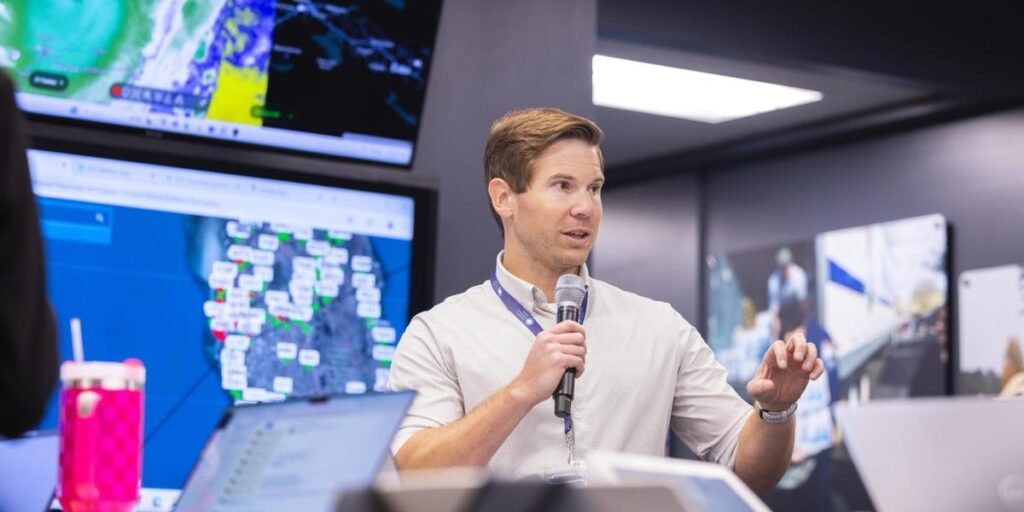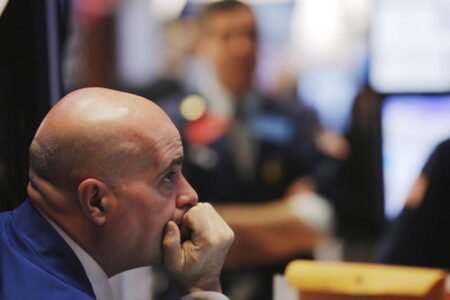- With hurricane season in full swing, Walmart’s emergency response team is working overtime.
- The company’s response to storms like Hurricane Milton is coordinated by meteorologist Tom Bedard.
- Bedard walked BI through a recent day on the job, which he said gives the retailer the information it needs to keep people safe.
“Gray-sky days” start around 3:45 a.m. for Walmart’s in-house meteorologist, Tom Bedard.
When storms are brewing offshore, the 32-year-old Texas native told Business Insider he’s up in time to read through the 4 a.m. note from the National Hurricane Center with the latest details — the first of four daily dispatches that are scheduled every six hours while the storm is tracked.
Two weeks ago, it was Helene ripping through Appalachia. This week, it’s Hurricane Milton bearing down on the Gulf Coast of Florida.
With more than 5,200 retail locations across the US, not to mention warehouses, trucks, and other support facilities, severe weather is a significant concern to Walmart, especially during hurricane season.
Bedard arrived at Walmart just after Idalia — the only hurricane to make landfall in the US last year — following six years at AccuWeather and five years at the National Disaster Preparedness Training Center.
Now, as Milton gathers steam, Bedard is responsible for leading a group of 10 emergency support groups that cut across all divisions of the retail giant, ranging from store operations to logistics and more.
“We’ve been coordinating across all different parts of the business unit to make sure that what we’re doing for the field comes down with one voice,” he told BI. “We’ve got a responsibility, first and foremost, to make sure our associates are safe, and that if there’s a facility that’s in an evacuation area, that folks are taking the proper action.”
As of Wednesday afternoon, more than half of the company’s 385 retail locations in Florida were closed in anticipation of Milton’s arrival, according to the company’s status tracker.
While Bedard said he and other meteorologists generally avoid making specific recommendations about what other teams in the company should do, his morning briefings are stacked with a hundred people in Bentonville and several hundred more online looking for guidance about what to expect.
Even CEO Doug McMillon and Walmart US CEO John Furner have attended several briefings this week and dropped in on the command center throughout the day to check on the storm’s progress, a spokesperson said.
“Instead of having all these different business units using different sources of weather, we’re able to come together and say, ‘This is the person that we work with in normal conditions to ensure we’re resourced for any natural disaster, and now this person’s giving us the weather information when we need it most,” Bedard said.
Under normal conditions, or “blue-sky days,” Bedard spends his time meeting with people across the company and helping draft the plans that will be set in motion when a significant weather event is on the horizon.
“That’s what they teach us in our entry-level emergency management courses is develop those relationships, so when you need them at 3 o’clock in the morning for a tornado, you’ve got them right there,” he said.
Walmart’s sheer number of stores and its proximity to so many American households also means the retailer plays an outsize role in communities’ preparation for and response to disaster.
“We’re still heavily involved in Hurricane Helene’s recovery in the southeast and southern Appalachia,” Bedard said.
Walmart has so far committed $10 million to post-Helene efforts, a figure which includes donations of food, water, and essential supplies, as well as grants to relief organizations.
“When you need to make something happen, there’s a Sam’s Club or a supply chain facility that can be there to support it,” he added. “We want to support communities. As soon as we’ve got our associate safety taken care of, we really take great pride in what we’re able to do for communities across the nation.”
More than the bottomless espressos, what drives Bedard most during these storms is personal experience.
“Growing up in Houston in the 2000s, I got to see the Gulf Coast hurricane seasons at their worst. I was there for Katrina — being able to take in some of the Katrina refugees in Houston — and there for Rita,” he said. “Being able to learn more about something that terrified me is how I found my way into weather.”
Read the full article here

















